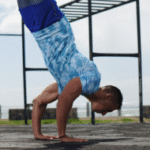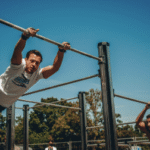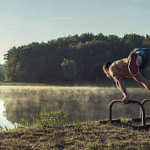Incorporating Mobility Work into Private Calisthenics Routines
- Understanding Mobility: More Than Just Flexibility
While often used interchangeably, flexibility and mobility have distinct meanings in the context of training:
Flexibility: Refers to the passive range of motion (ROM) of a muscle – how far a muscle can stretch. It’s largely about the extensibility of soft tissues.
Mobility: Is the active range of motion of a joint or series of joints. It encompasses flexibility, but also requires strength, control, and coordination throughout that full range. You might be flexible enough to touch your toes (passive), but true hip mobility means you can actively move your hips through a deep squat with control and strength.
In calisthenics, mobility is paramount because movements are dynamic and often require stability and control at the end ranges of motion.
- Why Mobility is Absolutely Crucial for Calisthenics Success
The demands of calisthenics make dedicated mobility work non-negotiable:
Skill Acquisition: Many advanced calisthenics skills have strict mobility prerequisites.
Handstands: Require significant shoulder flexion, wrist extension, and thoracic spine extension.
Planche: Demands extreme wrist extension and shoulder protraction/depression.
Muscle-ups/Straight Bar Dips: Need excellent shoulder extension and external rotation.
Pistol Squats/Deep Squats: Depend on ankle dorsiflexion, hip flexion, and knee mobility.
L-Sits/V-Sits: Require significant hamstring flexibility and hip flexor strength.
Without the necessary mobility, you simply cannot achieve or safely perform these skills.
Injury Prevention: Poor mobility is a leading cause of injury. When a joint lacks its full range of motion, the body compensates by forcing movement through other joints (e.g., lower back compensating for tight hips in a squat) or by exceeding the safe limits of the restricted joint. This leads to strains, sprains, and chronic overuse injuries (common in shoulders, wrists, elbows, and lower back for calisthenics practitioners).
Performance Enhancement: Improved mobility allows for better movement mechanics, leading to:
Increased Power Output: A larger range of motion can increase the distance over which force can be applied.
Enhanced Muscle Activation: Better joint positioning allows target muscles to engage more effectively, leading to greater strength gains.
More Efficient Movement: Reduced friction and restriction mean less wasted energy.
Faster Recovery and Reduced Soreness: Mobility drills increase blood flow to muscles and joints, delivering nutrients and aiding in the removal of metabolic waste products, which can speed up recovery and alleviate post-workout soreness.
Longevity in Training: Prioritizing mobility ensures your joints remain healthy and functional, allowing you to continue practicing calisthenics safely and effectively for many years, avoiding common age-related stiffness.
Improved Posture: Many calisthenics movements inherently build strength in ranges that improve posture, and dedicated mobility work further enhances this by addressing tightness from modern sedentary lifestyles (common for busy professionals in Houston).
- How Private Calisthenics Coaches Incorporate Mobility Work
A private calisthenics coach in Houston plays a crucial role in integrating mobility, tailoring it to your unique body and goals:
Comprehensive Initial Assessment:
Before starting, the coach performs a detailed movement screening (e.g., overhead squat assessment, single-leg stance, various reaches) to identify specific mobility limitations, asymmetries, and potential areas of injury risk. This informs the entire training plan.
They consider your daily life (e.g., desk job, commute in Houston traffic) which often contributes to tight hips, stiff shoulders, and poor posture.
Customized Mobility Drills: Based on the assessment, the coach prescribes specific mobility exercises and stretches targeting your weakest links. This avoids generic routines and focuses on what you need most to unlock skills or alleviate pain.
Integrated Warm-ups:
Every private session begins with a dynamic warm-up specifically designed to prepare your joints and muscles for the day’s exercises. This involves controlled movements through a full range of motion (e.g., arm circles, leg swings, spinal rotations, cat-cow stretches).
Examples: For a handstand session, the warm-up would heavily emphasize wrist mobility (wrist circles, wrist extensions) and shoulder flexibility (shoulder dislocations with a band, arm circles).
Targeted Cool-downs:
Post-workout, the coach guides you through static stretches and longer-hold mobility exercises. This helps improve overall flexibility, aids muscle relaxation, and can reduce post-workout stiffness.
Examples: Pigeon stretch for hip mobility, prone chest stretch for shoulders, specific hamstring stretches.
Dedicated Mobility Sessions/Blocks:
Depending on your goals and limitations, the coach might program entire shorter sessions focused solely on mobility (e.g., 20-30 minutes, 2-3 times a week, possibly on rest days). This is crucial for addressing significant mobility deficits.
These might involve longer holds, PNF (Proprioceptive Neuromuscular Facilitation) stretching with a partner, or even active isolation stretching.
“Pre-habilitation” (Pre-hab):
The coach integrates exercises designed to strengthen muscles around vulnerable joints (e.g., rotator cuff exercises for shoulder health, forearm exercises for wrist stability) to prevent injuries before they occur.
Active vs. Passive Stretching: The coach educates on when to use dynamic (pre-workout, active movements) versus static (post-workout, held stretches) versus active (using muscle contraction to achieve stretch) stretching, tailoring the approach to specific goals.
Self-Myofascial Release (SMR): Coaches often teach clients how to use tools like foam rollers, lacrosse balls, or massage guns to release muscle tightness and improve tissue extensibility, which complements active mobility work.
Integration with Strength Work: The coach might pair mobility drills between sets of strength exercises (e.g., doing hip mobility drills during rest periods of squats) to maintain range of motion throughout the workout.
Breathing and Core Integration: Proper breathing patterns are often tied to mobility, especially in the thoracic spine and hips. The coach might incorporate breathing drills into mobility work.
- Specific Mobility Areas Crucial for Calisthenics
A calisthenics coach will pay particular attention to:
Shoulders: Flexion (overhead reach), extension, internal/external rotation, scapular control (protraction, retraction, elevation, depression). Essential for handstands, planche, pull-ups, dips, muscle-ups.
Wrists: Extension and flexion. Vital for handstands, planche, L-sits, and any ground-based bodyweight exercises.
Hips: Flexion, extension, internal/external rotation. Crucial for deep squats, pistol squats, L-sits, leg raises, and overall lower body power.
Thoracic Spine (Upper Back): Extension and rotation. Often neglected but critical for overhead movements, handstand alignment, and preventing lower back compensation.
Ankles: Dorsiflexion and plantarflexion. Important for deep squats, pistol squats, and maintaining balance.
In the Houston Context:
For calisthenics practitioners in Houston, incorporating dedicated mobility work in private sessions is particularly beneficial:
Counteracting Sedentary Lifestyles: Many Houstonians have demanding jobs that involve prolonged sitting, leading to tight hips, stiff shoulders, and poor posture. Mobility work directly addresses these common issues.
Maximizing Park Training: If you train outdoors in Houston’s parks, having the mobility to safely execute movements on bars and rings is paramount.
Busy Schedules: Private sessions ensure that mobility, often the first thing skipped in a rushed group setting or self-taught routine, is consistently prioritized and efficiently integrated.
Preventing Injuries: With a hot and humid climate, proper warm-ups and recovery-focused mobility can help prevent cramps and strains.
In summary, for long-term success and injury-free progression in calisthenics, mobility work is not optional; it is fundamental. A private calisthenics coach in Houston provides the expert assessment, customized programming, and meticulous guidance needed to effectively integrate mobility into your routine, unlocking new levels of strength, control, and skill mastery while ensuring your body remains healthy and resilient.

Incorporating Mobility Work into Private Calisthenics Routines
Route
Calisthenics Gym Houston Functional Bodyweight Training
Secondary phone: (346) 483-3195
Email: info@calisthenicsclubhouston.com
URL: https://calisthenicsclubhouston.com/
Monday 6:00 AM - 7:00 PM Tuesday 6:00 AM - 7:00 PM Wednesday 6:00 AM - 7:00 PM Thursday 6:00 AM - 7:00 PM Friday 12:00 PM - 6:30 PM Saturday 9:45 AM - 12:00 PM Sunday 3:00 PM - 5:00 PM





